
While the disciplines may share at least some of the same principles, there are many crucial differences between B2B and B2C marketing. One of the main challenges facing B2B marketers is the task of selling functional or uninspiring products to professional buyers, in an environment where conventional marketing techniques hold little value.
The process becomes even more challenging when selling these products online, as your prospective clients cannot touch the merchandise or interact with a knowledgeable salesman. With this in mind, you will need to think strategically if you are to successfully engage professional buyers and sell your industry goods.
So, here are three simple steps that will enable you to successfully market and sell your industry products through an online platform: –
- Overeducate buyers and sell your Unique Value Proposition
As B2B marketers cannot use gimmicks or overly creative campaigns to sell their products, they must instead focus on the unique value proposition of what they are selling. This instantly creates a more focused and targeted marketing campaign which has a far greater chance of succeeding.
The way to achieve this through an online platform is to overeducate your clients, providing concise and relevant information that includes detail, images and consumer reviews. Amazon offers an excellent example of this, as it deliver the kind of in-depth data and insight that value-focused buyers demand in the modern age.
The MCS Test Equipment website is also extremely informative and well-organised, with complex data explained in-depth and all products categorised logically. This site also offers a prime example of how a blog resource can be used to educate buyers, supplementing the information featured on your individual product pages.
- Publish your Prices and Pricing Structure clearly
The motivation of B2B buyers is relatively easy to understand, as they aim to acquire cost-effective products that offer exceptional value and help to drive higher profit margins. In this respect, the pricing strategy that underpins your products is pivotal, both in terms of the savings that it delivers to buyers and how you market this.
The bottom line is transparency, especially if prices vary between small, medium and enterprise companies. The worst thing is to market products at different prices to alternative buyers, especially if you have not published your variable price points on your website beforehand. This can lead to confusion among buyers, while minimising your chances of developing price-qualified leads that convert interested parties into clients.
- Optimise your website
This is one of the golden rules of any e-commerce venture, regardless of whether you are selling to individual customers or businesses. Without an accessible, well-structured or fast-loading website, you find it impossible to market your products at busy and organised buyers.
The first area to address is the layout of your website, which must be logically structured and designed to funnel buyers towards a direct action. This journey must be concise and simple, enabling B2B buyers to identify products, research them in detail and complete a purchase. It is also imperative that you optimise the loading times of individual landing pages, as it is estimated that anything over two seconds triggers significantly higher bounce rates.
This is particularly relevant in the B2B sector, where time is money and buyers are likely to be deterred by a slow and cumbersome website. So not only should you strip any complex graphical elements or unnecessary animations from the site, but the Inbound Tom website also suggests that you use Google Speed Insights to highlight specific issues with individual pages. This can provide practical insight and advice on how to improve your website and sell B2B products more effectively.
Related posts:






